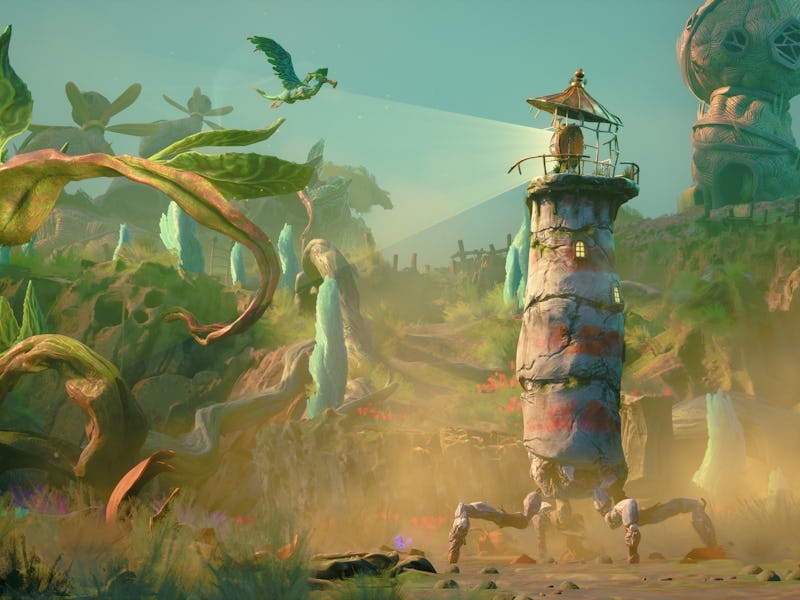This Day One Indie Is Everything Right With Game Pass
Weird games are worth it.

Art is hard. People universally say they like art, or think art is a good thing. But getting something artistic in front of a big audience is exceedingly rare these days. You can point to budgets or social media or venture capitalists as the cause for much of this milquetoast media, but the silver lining is that cool art still happens. And, in the case of the latest Day One indie sensation on Game Pass, it can still find a following.
To call Double Fine’s latest release Keeper an indie is a semantic stretch. Obviously anything backed by the conglomerate cash pile that is Microsoft isn’t exactly in hardscrabble bootstraps territory; however, it’s clearly indie in spirit. You play as a lighthouse that walks around and shines a light on stuff to solve puzzles. Not much of an elevator pitch, but the execution is what makes that oddball premise so successful. Keeper is an exercise in vibe and aesthetics so captivating it reminds us that Game Pass can occasionally be a vehicle for something truly grand.
Keeper lands as a beautifully strange and singular experience that feels like the kind of game big publishers used to avoid. Most games’ heroes are human, human‐adjacent, or humanoid. Keeper breaks that mold in dramatic fashion. You assume the role of a living lighthouse that has sentience, legs, and a purpose. The lighthouse awakens on a remote island in a long-lost sea, in the shadow of a mountain, and is joined by Twig, a seabird companion it saves from a swarm of malevolent energy in the opening moments of the game.
This tower + bird pairing is such an odd yet charming combo. They move together through a ruined world that is both silent and expressive. A close analogue would be 2012’s Journey, a similarly artistic surprise that won a huge audience thanks to how deftly it played with our emotions. Much like Journey, the main objective of Keeper is singular and clear. Soon after gaining bipedal sentience the lighthouse sees a mystical vision on a distant mountaintop and off you go.
It’s as unconventional as it gets. You’re not controlling a heavily-armed hero or a squad of soldiers. Instead, you’re guiding a mystical, lumbering structure of light, alongside a small creature that provides agility, curiosity, and companionship. This creates a relationship that is defined by movement and tone, not dialogue and cutscenes. It feels intimate and fresh.
Keeper reminds us that friendship can take many forms.
Gameplay in Keeper is built less around traditional combat or flashy action, more around exploration, puzzles, and the interplay between your beam of light and the world. The lighthouse beam is your main mechanic for illuminating paths, activating mechanisms, and clearing corrupting tendrils of Wither, the evil dark magic coursing across the world.
Twig’s role is complimentary but no less important. He does the obvious things you’d expect a bird to do like reaching levers and whatnot to help solve puzzles. But the game goes beyond a Banjo Kazooie-esque dynamic to explore more surreal elements. In certain contexts the beam can manipulate time, and Twig, turning him into a phantom that can move through walls or back into an egg you can use for weight-based triggers. All of this is done purely with environmental context and visual cues. As a game Keeper has the bones of a fairly traditional puzzler, but as an experience it’s something much more layered and complex.
Surreal environments convey more mood and emotion than most cutscenes ever could.
This is where Double Fine’s DNA shows strongly. The team is known for games that mix whimsy and emotional depth, and Keeper feels like a distilled version of that ambition. The world is post-human, inspired by the isolation brought on in 2020. But the focus on natural ecosystems gives the vibe a warmly post-apocalyptic feel, a fertile ground for the budding friendship you feel for Twig. The stylized surrealism helps too, a psychedelic injection inflating the lucidity of the dreamscape. It’s no accident the main mechanic is simply looking around because that’s exactly what you want to do every step of the way.
Keeper also demonstrates that big‐studio backing doesn’t always mean blockbuster churn. While modest in length (around six hours), it is focused, and unafraid to be itself. The synergy of protagonist, mechanics, and mood makes it more than novelty. It’s profound, compelling and aesthetically resonant. For anyone interested in games as more than just entertainment, this is one of the year’s brightest and most understated gems. Give yourself the six-hour journey, play it in a comfortable setting, and let the mood speak where words are absent.